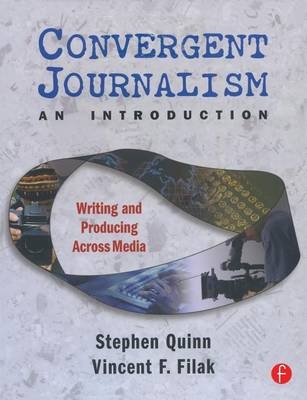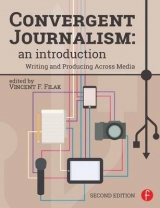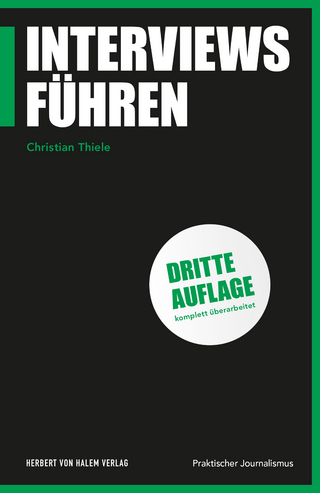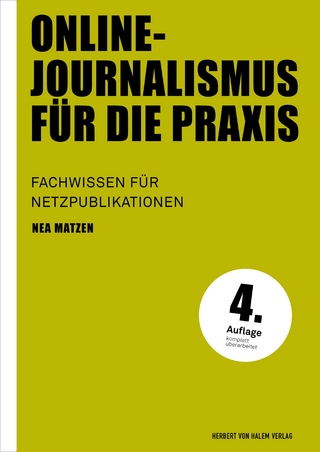
Convergent Journalism an Introduction
Focal Press (Verlag)
978-0-240-80724-9 (ISBN)
- Titel erscheint in neuer Auflage
- Artikel merken
Learn how to deliver news in any and all media. This one volume teaches you how to master all of the skills needed to be a converged journalist. Don't think only broadcast or print. Think online, air waves, magazines, PDAs, cell phones and electronic paper. Convergent Journalism an Introduction explains what makes a news story effective today and how to recognize the best medium for a particular story. That medium may be the web, broadcast, radio, or a newspaper or magazine - or, more likely, all of the above. This text will explain how a single story can fulfil its potential through any media channel. Convergent Journalism an Introduction shows you, the news writer, editor, reporter, and producer how to tailor a story to meet the needs of various media, so your local news story can be written in a form appropriate for the web, print, PDA screen and broadcast.
Stephen Quinn is an associate professor of journalism in the Faculty of Arts at Deakin University in Australia. He previously served as an associate professor of journalism at Ball State University and as both the director of the Center for Media Training and Research and an associate professor of journalism at Zayed University in Dubai in the United Arab Emirates. He has also taught journalism in the UK, Australia and New Zealand. Between 1975 and 1990, Quinn worked full time as a reporter, writer, editor and columnist in Australia, Thailand, the UK and New Zealand. He started with regional newspapers in Australia (the Newcastle Herald) and has worked -- in chronological order -- for the Bangkok Post, the Press Association in London, BBC-TV, the Australian Broadcasting Corporation, Television New Zealand, Independent Television News in London, and The Guardian in London. He received his bachelor's degree from the University of Newcastle in Australia, his master's degree from The City University in London and his Ph.D. from the University of Wollongong in Australia. Quinn is the author of Convergent Journalism and Conversations on Convergence (both New York: Peter Lang 2005) Knowledge Management in the Digital Newsroom (Oxford: Focal Press 2002), Digital Sub-Editing and Design (Oxford: Focal Press 2001), Newsgathering on the Net second edition (Melbourne: Macmillan 2001) and The Art of Learning (Sydney: UNSW Press 1999). Vincent F. Filak is an assistant professor at Ball State University where he teaches undergraduate courses in news writing and graduate courses on media theory. He also serves as the faculty adviser to The Ball State Daily News, the university's award-winning newspaper. Prior to his arrival at Ball State, he taught news writing and reporting at the University of Wisconsin and the University of Missouri. He also worked as a night-side city desk reporter at the Wisconsin State Journal in Madison, Wisconsin. He received a bachelor's degree and a master's degree in journalism from the University of Wisconsin and a Ph.D. from the University of Missouri. His dissertation examined how inter-group bias between print and broadcast journalists can create problems for converging newsrooms. He has conducted several studies and has published scholarly work on this topic. He has also published research on media coverage of the Sept. 11 terrorist attacks and the impact of psychological need-satisfaction on college learning. Filak serves as a reviewer for the Atlantic Journal of Communication and the Newspaper Research Journal. He is a member of College Media Advisers, the Association for Education in Journalism and Mass Communication and Kappa Tau Alpha, the national honor society in journalism and mass communication.
Chapter 1: What is convergence and how will it affect my life?
Author: Stephen Quinn, professor of journalism
- Defines the issues
- Sets the scene
- Shows how convergence is evolving worldwide
- Discusses the technologies driving convergence
- Outlines the skills that next-generation journalists will need
- Discusses the possible futures journalism faces
Chapter 2: The multi-media assignment editor and producer
Author: Terry Heifetz, managing editor NewsLink Indiana converged news service
- Convergence as event-driven news; therefore role of assignment editor is key
- Roles of producer and assignment editor (in detail); how they work together
- Differences in the positions between traditional and converged newsrooms
- Strengths of each type of media
- Organizing a program
Chapter 3: Words: The foundation stone of journalism
Author: Vincent F. Filak, assistant professor of journalism and advisor to Daily News
- The written word and its value to all forms of media
- In the world of converged media, employers are still looking for good writers.
- The re-emergence of the inverted pyramid and writing tight. What writers need to get information to people.
- Tight and smart writing doesn't mean boring writing. Ways to make your writing both crisp and engaging.
- A second look: How to edit yourself and get the piece ready for public consumption. Discusses adding enough background, reading something out loud, asking yourself questions and so forth.
Chapter 4: Broadcast writing and speaking
Author: Robert A. Papper, professor of telecommunications
- How to write and broadcast news for radio
- Writing for the ear in radio
- Writing for the eye
- Blending script and picture
Chapter 5: Writing for the web
Author: Wright Bryan, web news editor, NewsLink Indiana converged news service
- Is writing for the Web really different than writing for print?
- Electronic print reporting: A new way of moving print-style material
- Multimedia writing (the popular idea of convergence): Using all current writing skills (broadcast, print and information graphics) in one place
- "New" forms: Rise of the blog and the dominance of informality
- Rewrite specialist or reporter?: The organizational role of the Web writer
Chapter 6: Converged graphics across all media
Author: Jennifer George-Palilonis, instructor of journalism and graphics co-ordinator
- An outline of the basics of graphics reporting, regardless of the platform
- How convergence affects visual reporting from print, to web, to broadcast graphics
- Main differences among print, online and broadcast graphics
- How a visual concept changes as it makes the transition from newspaper, to web, to television
- How staffs might handle the challenges of making those adaptations happen
- Storytelling methods for multimedia graphics
- How a single story can be best served graphically across three different media platforms
Chapter 7: Digital still photography
Author: Thomas A. Price, assistant professor of journalism and photojournalism coordinator
- Brief history of effects of technology on photographic reporting
- The iconographic nature and power of the still photograph versus the passive involvement with the video image
- How convergence affects photographic reporting as to final intended product
- How editors view and select photographs for different target media
- Differences in story-telling techniques for different media
- Positive and negative aspects of the "platypus or multi-media photographer
- Conflicting ethical standards among the different outlet media.
Chapter 8: Digital video photography
Author: Tim Underhill, production manager, NewsLink Indiana converged news service
- The professional television camera
- Composing images for the screen, television and computer.
- Shooting sequences, the basis for good storytelling.
- Audio, a sound foundation.
- Putting it all together to tell a story
Chapter 9: Editing for moving pictures
Author: John C. Dailey, assistant professor of telecommunications
- Shooting with the editor in mind
- Welcome to Final Cut Pro
- Capturing, the browser, the canvas and the timeline
- Simple editing
- Fancy stuff (filters, text and transitions)
- Print to tape
Chapter 10: Multi-media journalism: putting it all together
Author: Stephen Quinn, professor of journalism
- A new storytelling form
- Tools for multi-media journalism
- Back-pack journalism versus single skill journalism
- Interactivity
Chapter 11: Multi-media advertising
Author: Michael Hanley, assistant professor of journalism
- Introduction: Media advertising during the Dark Ages (1880 -1990)
- Weaving a new web
- Multi-media gets personal
- Interactivity and digital media
- The future at your fingertips
Chapter 12: Multi-media public relations
Author: Robert S. Pritchard, assistant professor of journalism
- Public relations in a wired world: what's changed and what hasn't
- Using multi-media to build relationships
- Using multi-media to communicate with the media
- Using multi-media to communicate with employees
- Using multi-media to communicate with the community
Chapter 13: Where do we go from here? Possibilities in a convergent future
Author: Stephen Quinn, professor of journalism and Vincent F. Filak, assistant professor of journalism
- Where is convergence leading us?
- Dealing with cultural issues
- What further skills do you need?
Author biographies + pix
Index
| Erscheint lt. Verlag | 4.10.2005 |
|---|---|
| Verlagsort | Oxford |
| Sprache | englisch |
| Maße | 189 x 246 mm |
| Gewicht | 590 g |
| Themenwelt | Sozialwissenschaften ► Kommunikation / Medien ► Journalistik |
| ISBN-10 | 0-240-80724-3 / 0240807243 |
| ISBN-13 | 978-0-240-80724-9 / 9780240807249 |
| Zustand | Neuware |
| Informationen gemäß Produktsicherheitsverordnung (GPSR) | |
| Haben Sie eine Frage zum Produkt? |
aus dem Bereich



